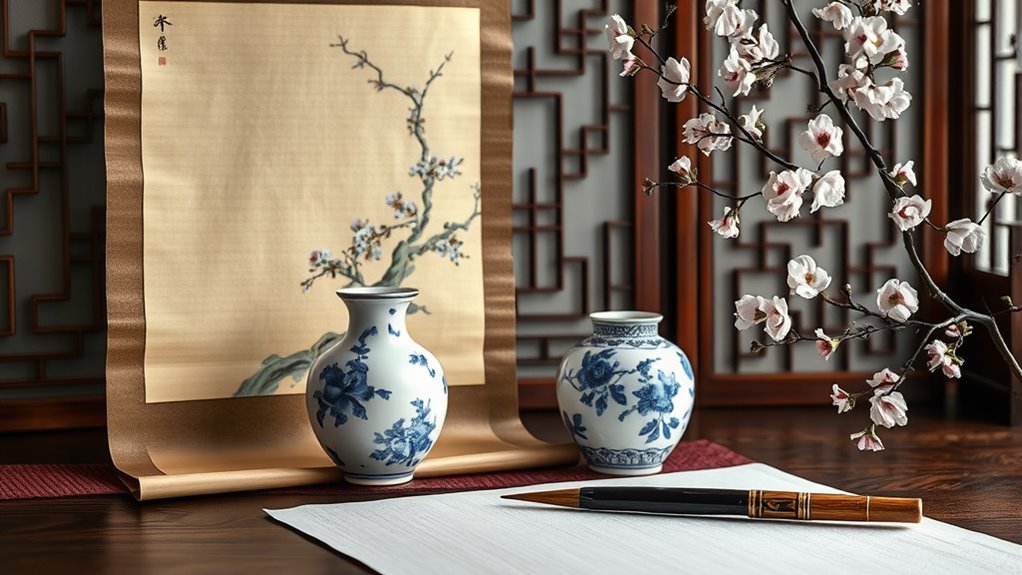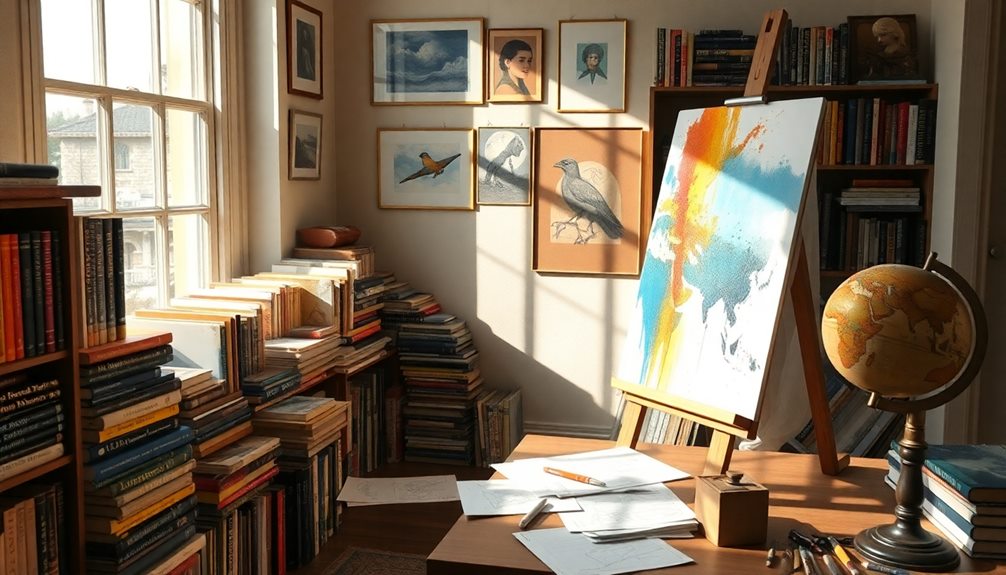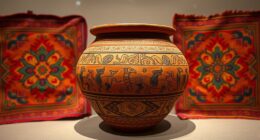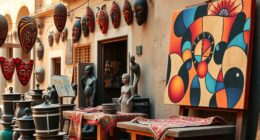The art of East Asia highlights the rich cultural and philosophical roots of China and Japan. Chinese art showcases elegant calligraphy and porcelain that reflect harmony, discipline, and moral virtue. Japanese art emphasizes simplicity, natural beauty, and mindfulness through styles like Zen ceramics and understated calligraphy. Both traditions embody values of harmony with nature and spiritual discipline. Exploring these artistic expressions reveals deeper insights into their cultural identities—continue to discover the fascinating connections and unique qualities behind these timeless visual forms.
Key Takeaways
- East Asian art reflects deep philosophical and cultural values, emphasizing harmony, nature, and spiritual discipline.
- Chinese calligraphy and ceramics exemplify mastery in expressive brushwork and intricate craftsmanship.
- Japanese art highlights simplicity, natural beauty, and the wabi-sabi aesthetic, emphasizing imperfection and transience.
- Calligraphy, especially shodo, serves as both an artistic and meditative practice rooted in Zen principles.
- Ceramic traditions like Raku and Oribe embody understated elegance and mindfulness, blending functionality with artistic expression.

Have you ever wondered how East Asian art reflects centuries of cultural evolution and philosophical ideas? It’s a fascinating journey through centuries of tradition, where every brushstroke and sculpted vessel carries deep meaning. When you explore Chinese and Japanese art, you begin to see how their unique styles and techniques embody core cultural values and philosophies. Two essential aspects that stand out are calligraphy techniques and ceramic craftsmanship, which reveal much about the societies that created them.
East Asian art reflects deep cultural values through calligraphy and ceramics, embodying philosophy and tradition.
In Chinese art, calligraphy isn’t just a way of writing; it’s a revered art form that embodies the harmony between form and spirit. When you study Chinese calligraphy, you notice how each stroke is deliberate, expressive, and infused with philosophical significance. The brushwork varies from bold, vigorous lines to delicate, flowing curves, demonstrating mastery over brush and ink. The techniques used require patience and skill, as each character becomes a reflection of the artist’s inner state. This art form is often seen as a visual expression of Confucian ideals of discipline and harmony, blending aesthetic beauty with moral virtue. Chinese ceramic craftsmanship also speaks volumes about cultural evolution. From the delicate blue-and-white porcelain to intricate pottery, these objects showcase advanced techniques in glazing, shaping, and decoration. When you hold a Chinese porcelain piece, you’re holding centuries of innovation, where artisans perfected their craft to produce durable yet beautiful objects. The craftsmanship reflects both aesthetic sensibility and practical ingenuity, with motifs often inspired by nature or philosophical symbols, emphasizing harmony between humans and the natural world.
Japanese art, meanwhile, emphasizes simplicity, natural beauty, and subtlety. Calligraphy in Japan, known as shodo, shares roots with Chinese traditions but incorporates distinct stylistic elements that highlight Zen principles. When you observe Japanese calligraphy, you’ll notice a focus on spontaneity and the beauty of imperfect lines—an embodiment of wabi-sabi, the appreciation of transience and imperfection. Just as in Chinese practices, calligraphy is a spiritual discipline that cultivates mindfulness. Japanese ceramic craftsmanship is equally impressive, with techniques refined over centuries. You’ll find that Japanese pottery often emphasizes understated elegance, with styles like Raku and Oribe showcasing distinctive glazes and forms. These ceramics are not just functional but are appreciated as art, embodying the Zen ideals of simplicity and mindfulness. The meticulous craftsmanship in Japanese ceramics reflects a deep respect for natural materials and a desire to create objects that harmonize with one’s surroundings.
In both Chinese and Japanese traditions, art becomes a mirror of philosophical thought and cultural identity. Whether through the expressive calligraphy techniques or the refined ceramic craftsmanship, these ancient practices continue to influence and inspire, revealing a profound connection to their philosophical roots and cultural evolution.
Frequently Asked Questions
How Did East Asian Art Influence Western Artistic Movements?
You can see how East Asian art influenced Western artistic movements through cross-cultural exchange, inspiring artists like Monet and Van Gogh. They admired techniques like ink wash painting and the use of negative space, which led to Western adaptation of these styles. This cultural exchange broadened artistic horizons, encouraging experimentation and blending Eastern aesthetics with Western themes, ultimately enriching the development of modern art across the globe.
What Role Did Religion Play in Shaping East Asian Art?
Imagine a sacred garden where each flower whispers stories of faith. You see, religion deeply shapes East Asian art through religious symbolism and spiritual practices. Artists use symbols like dragons, lotus flowers, and calligraphy to express spiritual beliefs and divine harmony. These elements serve as allegories, connecting viewers to sacred concepts, guiding them through a visual journey of reverence, spiritual devotion, and cultural identity woven into every brushstroke and carving.
How Are Contemporary Artists Integrating Traditional Techniques Today?
You see contemporary artists integrating traditional techniques through innovative methods and modern adaptations. They preserve the essence of ancient craft while experimenting with new materials and concepts, blending old and new seamlessly. This approach allows them to honor cultural heritage while making their art relevant today. By combining traditional techniques with contemporary ideas, they create dynamic works that bridge the past and present, enriching the ongoing dialogue in East Asian art.
What Are the Major Differences Between Chinese and Japanese Art Philosophies?
You might think all East Asian art philosophies are similar, but Chinese and Japanese traditions differ markedly. Chinese art emphasizes philosophical foundations like Daoism and Confucianism, focusing on harmony and balance. Japanese art highlights aesthetic principles such as simplicity and nature’s beauty, influenced by Zen Buddhism. These differences shape their unique approaches, with Chinese art often grand and detailed, while Japanese art tends to be minimal and subtle.
How Has East Asian Calligraphy Evolved Over Centuries?
You see that East Asian calligraphy has evolved through centuries, with various calligraphy styles emerging and transforming over time. You notice how brush techniques have become more refined, reflecting cultural shifts and individual expression. As you explore, you’ll find that modern calligraphy blends traditional brush techniques with new styles, creating a dynamic art form that honors its rich history while embracing innovation.
Conclusion
As you explore the rich tapestry of East Asian art, you’re transported to tranquil bamboo groves and serene ink-painted landscapes. The delicate brush strokes and intricate details whisper stories of centuries-old traditions and philosophies. With each piece, you feel the harmony of ancient wisdom and artistry blending seamlessly, inviting you into a world where beauty and spirituality intertwine. Embrace this timeless heritage, and let it inspire your appreciation for the profound artistry that continues to blossom across China and Japan.









